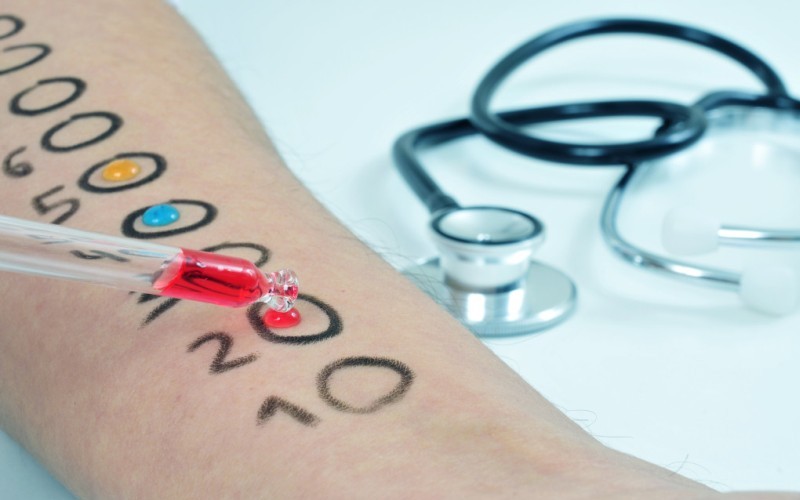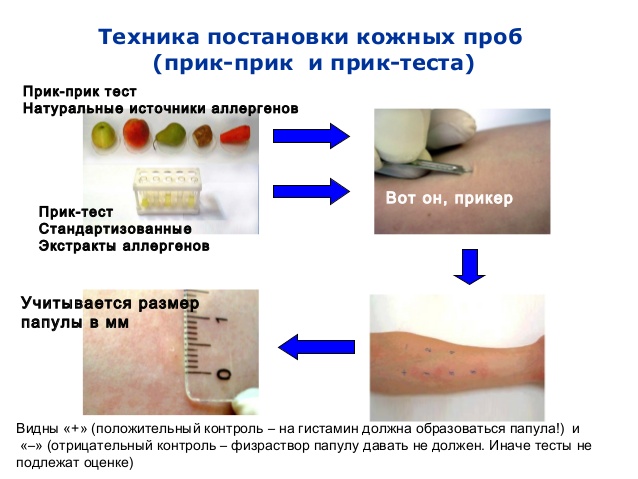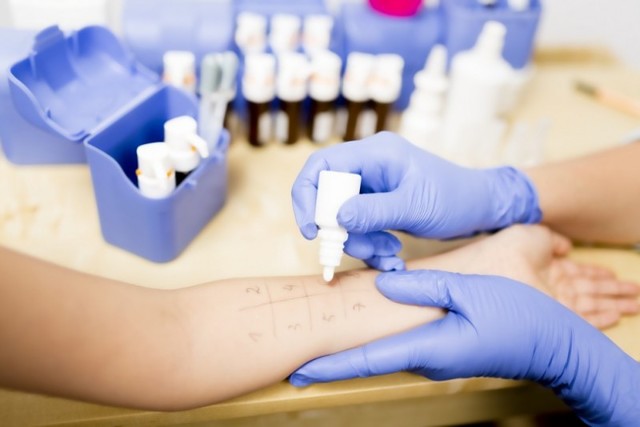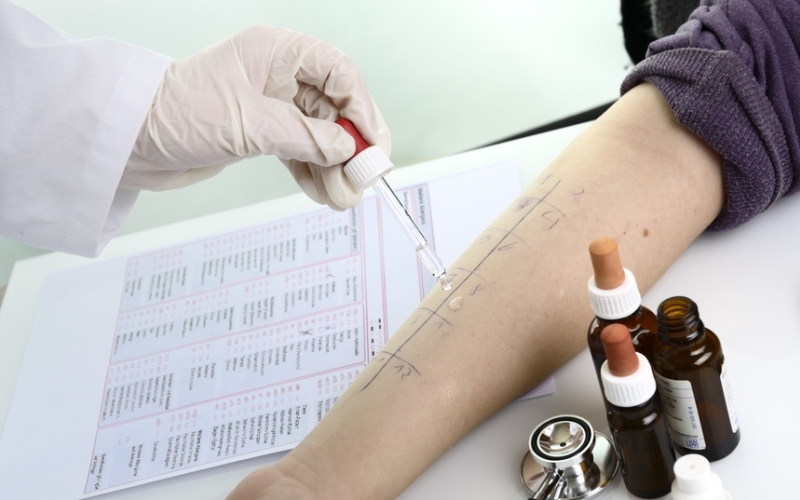At the stage of diagnosis of an allergic disease are prescribed allergen tests. A painless study allows you to identify an individual spectrum of allergens.
Contents [hide]
- Varieties of tests for allergies
- SKO-test to allergies-Indications
- How to prepare for allergy tests correctly?
- How do allergic tests are performed?
- Intradermal tests for allergies - reaction assessment
- Allergy tests: when are they prescribed?
- Allergies: contraindications for conducting
- The most common allergens
- Video: Allergies test at home - Instruction
Let us consider in more detail the varieties of tests for allergies and the key differences between them.
Varieties of tests for allergies
Various methods are used to identify allergies to a particular substance. In practice, several effective diagnostic methods are used.

- Blood analysis - reveals antibodies to specific stimuli. An effective test for allergens in the absence of skin samples.
- Scaring tests - Contact of the skin of the skin with the liquid that contains allergens.
- Costal samples - applications with allergens on the skin for the development of an allergic rash. A reliable result can only be evaluated after a couple of days.
- SKO-test to allergies - targeted piercing of the skin and the introduction of allergens under the epidermis. The most convenient and fast method of allergies test.
SKO-test to allergies-Indications
- With repeating food allergies, allergic rhinitis or asthma Most often, an allergist recommends conducting a hood test to allergies.
- For a skin test, be sure to use Certified materials. For reliable information, testing with a solution is carried out for a positive and negative result, which are further compared.
- The standard list of allergens of the SK-test includes pollen of several varieties of plants, insects, ticks and molds, food, animal and bird epithelium.
- In young children with the help of a hood test, allergies are revealed to food, especially vegetables and fruits. Such tests rarely give false results.
- In some cases, the results for various products give an equally positive result due to one similar component in the composition. With such coincidences, it is necessary to conduct molecular analysis for allergens.

How to prepare for allergy tests correctly?
Before taking allergy tests, it is important to adhere to recommendations:
- 7 days before the start of testing, exclude intake of antihistamines, antidepressants, hormones.
- Eat exclusively hypoallergenic products.
- Before the visit to the doctor to eat, the stomach should be full.

The patient must consciously comply with the doctor's recommendations. Failure to comply with one of the simple conditions will affect the false result. It is worth considering that in patients up to 2 years and older than 60, the results often do not correspond to reality.
- The result of the test for allergies with pronounced redness of the skin and papules up to half a centimeter is considered positive.
How do allergic tests are performed?
In solutions that are applied to the skin, add classic allergens - floral pollen, animal materials, medicinal components, products. Research methods are absolutely painless and in each individual case lead to different results. The course of the study depends on the variety of the test for allergies.
- For scaring test The forearm or upper back is treated with alcohol. At a distance of a few centimeters, the skin is specially injured by microzarapins using a Scarifier, to which a solution with allergens is further applied. For a quarter of an hour, the patient should limit mobility. Then with sterile agents, the remaining solutions of the skin are removed and the first assessment of the result is carried out.
- SKO-test to allergies It consists in applying the solution to the skin through which surface puncture of the skin is performed using a special needle. For one test you can produce about 10 samples. After 10-15 minutes, the presence of blisters on the skin is checked.
- Application test - A gauze swab is wetted in a solution with an allergen and applied in the form of a bandage on healthy areas of the skin. In contact with the irritant, the epidermis shows a positive or negative reaction.

The result is determined by the nature of redness of the skin and the presence of a skin rash.
Intradermal tests for allergies - reaction assessment
- The primary reaction of the body to the allergen manifests itself after 20-30 minutes. Then it is evaluated The reaction after two days.
- One allergy test allows you to identify or exclude about 2 dozen allergens. A doctor based on the patient’s history helps to choose a group of stimuli. The patient's complaints are compared, the age of what time of the year the disease falls and under what conditions.
- Allergy test result It can be either negative and positive. Doubtful results are checked by repeated analysis. The doctor prescribes treatment only on the basis of reliable results. Otherwise, medical appointments will be ineffective.

Allergy tests: when are they prescribed?
Allergy tests check the body's sensitivity to a group of allergens. The reaction of each person to the same allergen can manifest itself in different ways. Therefore, symptoms are evaluated by a doctor individually.
Characteristic symptoms for conducting skin tests for allergies:
- The inflammatory process in the respiratory tract, accompanied by a lack of oxygen.
- Inflammation and congestion of the nose with sneezing and itching, seasonal rhinitis.
- Itching and abundant rash On the skin, atopic dermatitis.
- Redness and abundant secretion of tears from the eyes, protracted conjunctivitis.
- An allergic reaction after eating.
- An allergic reaction to medications.
Allergies: contraindications for conducting
Research for possible allergens is carried out only during the period of remission of the disease.
Diseases that are a contraindication to allergies:
- Infectious diseases, flowed in acute form.
- Severe diseases of the chronic form.
- Autoimmune diseases.
- Weakened immunity.
- High probability of developing anaphylactic shock.
- Nervous and mental disorders.
- During pregnancy and breastfeeding.
- Oncological diseases.
- AIDS.
In the presence of one of the contraindications, testing is carried out only using a blood test.
The most common allergens

An allergic reaction is most often provoked by typical allergens, which include:
- Household - dust, furniture and bed ticks.
- Pollen allergens- Cereal crops, meadow herbs, flowering trees and shrubs. Call seasonal allergies.
- Animals of allergens - saliva, organics, animal hair and domestic insects.
- Fungal allergens - fungi on the walls of rooms, microorganisms in old furniture, fungi that live in the external environment. They cause year -round allergies.

In the presence of one of the above stimuli in combination with characteristic symptoms, you should consult a allergist.
We also advise you to read:
- The best eye drops to improve vision
- Point of youth and longevity
- What does an orthopedist look at children?
- Lack of potassium in the body
- My girlfriend is pregnant - what to do







